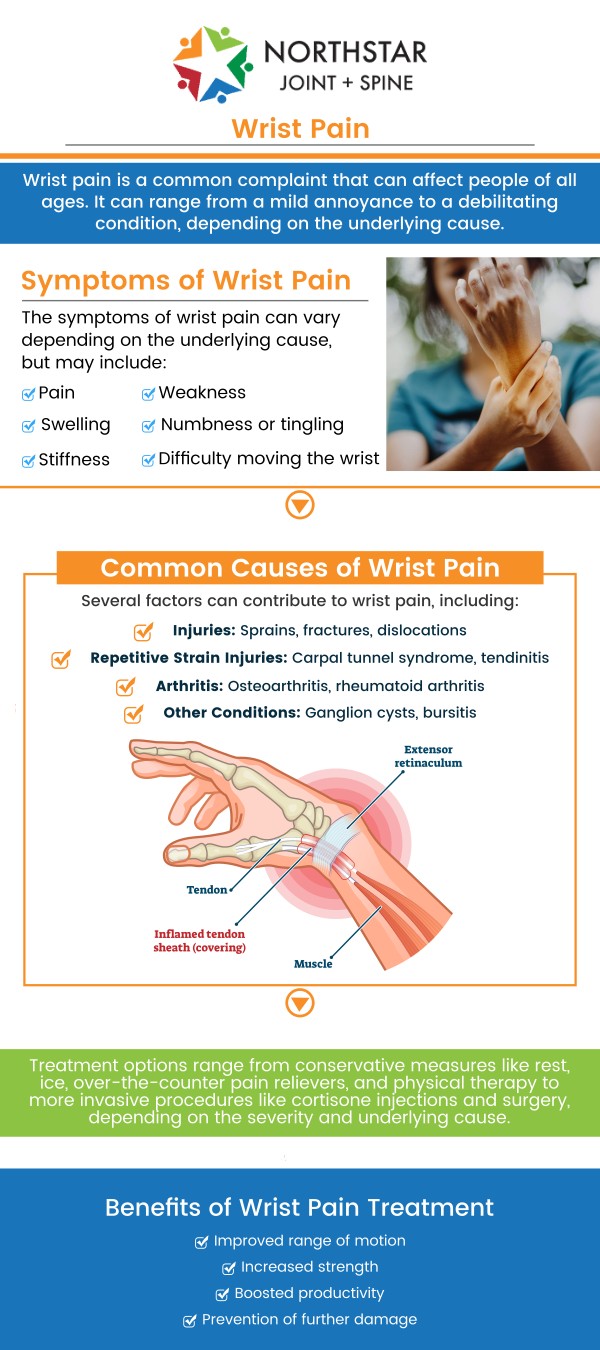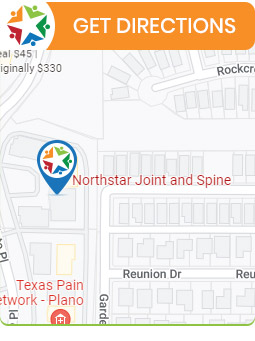Wrist Pain Causes and How to Identify Them
Wrist pain can stem from various causes, including arthritis, tendonitis, and nerve compression. Identifying the root cause requires a thorough evaluation of symptoms and physical examination. Advanced imaging, such as X-rays or MRIs, may also be used for a more accurate diagnosis. Board-Certified Dr. Robert J. Nocerini, MD, at Northstar Joint and Spine, specializes in diagnosing and treating wrist pain to restore function and relieve discomfort. For more information contact us today or schedule an appointment online. We are conveniently located at 7704 San Jacinto Pl Suite #200 Plano, TX 75024.


Table of Contents:
What are the most common causes of wrist pain?
How does carpal tunnel syndrome cause wrist discomfort?
Could arthritis be the reason for my wrist pain?
When should I see a doctor for persistent wrist pain?
How Dr. Robert J. Nocerini Diagnoses the Root Causes of Wrist Pain in Plano, TX
Wrist pain can arise from a variety of conditions, many of which are linked to repetitive movements or underlying health issues. One common cause is tendinitis, which occurs when the tendons in the wrist become inflamed. This often happens due to overuse, such as frequent typing, lifting, or repetitive motions in sports or certain jobs. Carpal tunnel syndrome is another prevalent condition that causes wrist discomfort. It happens when the median nerve, which runs through the wrist, becomes compressed, often from activities that involve repetitive hand movements. This condition can result in tingling, numbness, and weakness in the wrist and hand.
Arthritis, particularly osteoarthritis, can also cause wrist pain. This condition involves the breakdown of cartilage in the joint, leading to inflammation, stiffness, and discomfort. Rheumatoid arthritis, an autoimmune disease, can similarly affect the wrist joints, causing persistent pain and swelling.
Another potential cause is ganglion cysts, which are non-cancerous lumps that develop along the tendons or joints in the wrist. These cysts can be painful, especially when they press on surrounding nerves. De Quervain’s tenosynovitis is another specific condition that leads to pain in the wrist, especially along the thumb side. It results from the irritation of the tendons in this area and is common among those who frequently grasp or twist objects. Finally, wrist pain can be linked to poor posture or improper ergonomics, leading to strain on the muscles and tendons over time.
Carpal tunnel syndrome (CTS) causes wrist discomfort by putting pressure on the median nerve, which runs through a narrow passage in the wrist known as the carpal tunnel. This tunnel is formed by bones and a ligament, and it contains several tendons that help control movement in the hand and fingers. When the tendons become inflamed due to overuse or other factors, they can take up more space within this confined area. This increased pressure on the median nerve can lead to symptoms such as pain, tingling, numbness, and weakness in the wrist, hand, and fingers.
The median nerve plays an important role in sensation and movement, especially in the thumb, index finger, middle finger, and part of the ring finger. As the pressure on the nerve builds, it disrupts its ability to function properly, causing discomfort. This can make it difficult to grip objects or perform tasks like typing, writing, or holding a phone.
In addition to swelling in the tendons, other factors like repetitive movements, poor posture, or an unhealthy wrist position can contribute to the development of CTS. For example, frequent activities such as typing on a keyboard, using a mouse, or engaging in manual labor that requires repetitive wrist motions can exacerbate the condition. Over time, this pressure can lead to persistent discomfort and, if untreated, may even affect the overall function of the wrist and hand. Early intervention is crucial to reducing the risk of long-term complications.
Arthritis can indeed be a significant factor in wrist pain, as it involves the inflammation of the joints, which can affect the wrist’s mobility and cause discomfort. There are different forms of arthritis that may affect the wrist, with osteoarthritis and rheumatoid arthritis being the most common culprits.
Osteoarthritis occurs when the cartilage in the wrist joint begins to wear down over time, leading to the bones rubbing against each other. This friction can result in pain, stiffness, and swelling, making it difficult to move the wrist freely. This condition is more common as people age or if there is a history of excessive strain on the wrist joints.
On the other hand, rheumatoid arthritis is an autoimmune condition where the body’s immune system mistakenly attacks the joints, including those in the wrist. This leads to chronic inflammation, pain, and swelling, and over time, it can cause damage to the joint structure, resulting in permanent deformities if not addressed. Unlike osteoarthritis, rheumatoid arthritis can occur in younger individuals and may affect both wrists simultaneously.
If you notice pain, swelling, or stiffness in your wrist that worsens over time or affects your daily activities, it may be an indication of arthritis. Early diagnosis and management are important to control symptoms and prevent further damage. Consulting with a healthcare provider can help determine if arthritis is the cause of your wrist discomfort and what treatments may be most beneficial.
Persistent wrist pain can be a sign of an underlying condition that requires medical attention. If the discomfort lasts for several days or weeks and does not improve with rest, it may be time to consult a doctor. A healthcare provider can assess the source of the pain and recommend appropriate treatment options. It is especially important to seek medical attention if the pain interferes with your ability to perform daily activities such as typing, writing, or lifting objects.
You should also consider seeing a doctor if you experience additional symptoms, such as swelling, warmth, or redness around the wrist, which could indicate inflammation or infection. Numbness, tingling, or weakness in the hand or fingers is another sign that medical evaluation is necessary. These symptoms may point to nerve compression or other issues that require specific treatment.
If you notice a limited range of motion in your wrist or find it difficult to move the joint, a doctor’s visit is recommended. Difficulty gripping objects or holding onto things can also signal a more serious condition affecting the wrist joint.
Board-Certified Dr. Robert J. Nocerini, MD, at Northstar Joint and Spine, specializes in diagnosing and treating wrist pain. With his expertise, Dr. Nocerini can determine the cause of your discomfort and create a personalized treatment plan to alleviate symptoms and improve function. Don’t wait too long to address persistent pain; early intervention can help prevent long-term complications and improve your quality of life.
The time it takes to see results from wrist pain treatment can vary depending on the cause of the discomfort, the severity of your symptoms, and the type of care you receive. Many patients notice early improvements within a few days to a couple of weeks when using supportive strategies such as gentle stretching, ergonomic adjustments, and rest. Treatments designed to reduce irritation may also help ease discomfort fairly quickly. However, consistent care is important, as wrist discomfort often develops gradually and may take time to fully resolve.
For more persistent or complex wrist pain, improvements may take several weeks as deeper tissues respond to targeted treatment. When working with a specialist such as Dr. Robert J. Nocerini, MD, at Northstar Joint and Spine in Plano, TX, patients receive a detailed evaluation and a personalized plan designed to deliver steady, meaningful progress. Depending on your condition, Dr. Nocerini may recommend therapies aimed at improving flexibility, supporting soft tissues, or enhancing joint function. Many patients experience noticeable relief as they follow their treatment plan, with continued progress over time.
Early evaluation and a structured, individualized approach offer the best chance for long-lasting results and a return to comfortable daily activity.
Board-Certified Dr. Robert J. Nocerini, MD, at Northstar Joint and Spine in Plano, TX, is dedicated to diagnosing the root causes of wrist pain with over 26 years of medical experience.
His approach includes:
• Comprehensive Patient Evaluation: Dr. Nocerini thoroughly reviews the patient’s symptoms, medical history, and daily activities to understand the specific wrist pain.
• Detailed Physical Examination: He performs a hands-on assessment, evaluating strength, flexibility, and identifying any abnormalities in the wrist joint.
• Advanced Imaging: To gain a deeper understanding, Dr. Nocerini may recommend X-rays or MRIs to check for conditions like arthritis, tendonitis, or nerve compression.
• Precise Diagnosis: Using his extensive knowledge and the latest diagnostic tools, Dr. Nocerini identifies the exact cause of the pain.
• Tailored Treatment Plans: Based on the diagnosis, Dr. Nocerini creates a customized treatment strategy to effectively relieve pain and improve wrist function.
As a board-certified specialist in Pain Medicine and Anesthesiology, Dr. Nocerini’s expertise ensures each patient receives the highest level of care, addressing their wrist pain with precision and a focus on long-term recovery. For more information contact us today or schedule an appointment online. We are conveniently located at 7704 San Jacinto Pl Suite #200 Plano, TX 75024. We serve patients from Plano TX, Willow Bend TX, Frisco TX, Allen TX, Addison TX, North Dallas TX, and surrounding areas.

Check Out Our 5 Star Reviews


Additional Services You May Need
▸ Back Pain
▸ Shoulder Pain
▸ Chronic Pain
▸ Epidural Steroid Injections
▸ Spinal Cord Stimulation
▸ Viscosupplementation
▸ Genicular Nerve Blocks
▸ Facet Injections
▸ Joint Injections
▸ Sacroiliac Joint Injections
▸ Lumbar and Cervical
▸ Facet Medial Branch Blocks
▸ Diagnostic Nerve Blocks
▸ Medication Management
▸ Neck Pain Doctor
▸ Diabetic Peripheral Neuropathy
▸ Headaches
▸ Suboxone
▸ Botox for Migraines
▸ Peripheral Nerve Stimulation
▸ Spine
▸ Joints
▸ Muscles
▸ Bones

Additional Services You May Need
▸ Back Pain
▸ Shoulder Pain
▸ Chronic Pain
▸ Epidural Steroid Injections
▸ Spinal Cord Stimulation
▸ Viscosupplementation
▸ Genicular Nerve Blocks
▸ Facet Injections
▸ Joint Injections
▸ Sacroiliac Joint Injections
▸ Lumbar and Cervical
▸ Facet Medial Branch Blocks
▸ Diagnostic Nerve Blocks
▸ Medication Management
▸ Neck Pain Doctor
▸ Diabetic Peripheral Neuropathy
▸ Headaches
▸ Suboxone
▸ Botox for Migraines
▸ Peripheral Nerve Stimulation
▸ Spine
▸ Joints
▸ Muscles
▸ Bones






